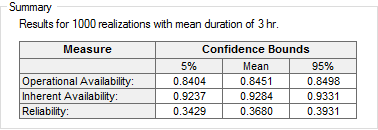The "Summary" portion of the dialog automatically displays the key reliability metrics (in terms of a mean and 5%/95% confidence bounds) after a simulation is run:

Mean Operational Availability. This statistic is the average fraction of time the component has been operating over the simulated time period. For a steady-state system, it represents the probability that the component will be operating at any given time.
Mean Inherent Availability. This statistic is the average fraction of time the component has been operable over the simulated time period. For a steady-state system, it represents the probability that the component will be operable at any given time. A component that is turned off or has unmet external requirements, but has not failed would be considered operable. Hence, the inherent availability The probability that the component will be operable at any given time (a component that is turned off or has unmet external requirements, but is not failed is considered to be operable). is always greater than or equal to the operational availability The probability that a component will be operating at any given time..
Reliability. This statistic is the fraction of realizations in which the component survived for the entire simulated time period. Hence, it represents the probability that the component will be operable for the entire simulation. For a steady-state system (with repeated failures and repairs) the system, by definition, has a 0 reliability.
- Availability and Reliability Histories and Statistics
- Availability and Reliability Results Summary
- Causal Analysis
- Defining and Using the Output Interface for a Reliability Element
- Exporting Availability and Reliability Summary Results
- Failure Times Statistics
- Reliability Element Status and Failure Mode Histories and Statistics
- Repair Times Statistics
- Saving and Accessing Reliability Results